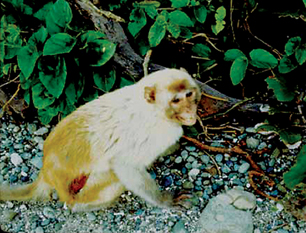2.7 Social competition, stress and subordination in animals
The behavioural tendencies of animals in situations of defeat and outranking, and hierarchies, have inspired insights into human mental health and well-being.
Living in a group entails competing with others for desirable resources such as food and mates. In many species such competition has led to the development of status hierarchies. Anyone who keeps chickens is well aware that there is a strongly enforced ‘pecking order’ amongst the hens. This was one of the first dominance hierarchies amongst animals to be described by scientists, and the term ‘pecking order’ was coined in this context.
Animals who accept subordination avoid fights with dominants; indeed they show clear signals of submission and readily cede space and resources to dominants. They may suffer harassment, displacement and bullying or scape-goating attacks from others (Figure 7, Figure 8).


Why do animals accept subordination in a hierarchy? The simple answer is that strongly social animals normally have no choice. They may be beaten in a fight by a stronger animal or an alliance of animals. But they may be better off remaining in the group because life alone, outside the group, may be even more stressful and dangerous than life as a subordinate. Being in such situations can be very stressful for animals, affecting the levels of stress hormones in their blood, their reproductive systems and their cardiovascular health (Sapolsky, 1998).
Animals that have been beaten and outranked typically give up – they readily respond in a submissive way to dominant animals, rather than fighting back. This appears to be an evolved, adaptive strategy to being defeated (in situations where rebellion is most unlikely to succeed): it is better to cut one’s losses and accept the status quo than to continue fighting and risk injury or even death.
How is this relevant to human mental health? We explore this in the next section.
